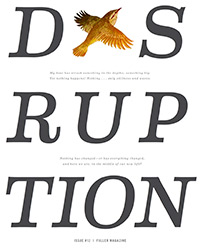The illustration and type on the cover of Fuller Seminary's magazine pretty much says it all. Rather than an evocative photographic portrait, as usually graces the cover, this one sports a photoshopped bird – gold and in flight – which forms the first “I” in the 200-point Century Bold italicized title that reads:
DIS
RUP
TION
Fuller magazine is always full of well-researched, well-written articles illustrated by gallery-worthy photography. Each issue is themed around culturally and religiously relevant issues. Written and illustrated by alumni, it is obviously meant to showcase the level of articulation and artistic ability of Fuller's student body.

This month’s theme – "Disruption" – brings together dozens of disparate voices to the biggest discussion of the seminary's recent history: the Big Move from its iconic campus nestled in upper-middle class Pasadena, with its plethora of fine restaurants, Arts and Crafts architecture, and wide leafy boulevards.
And its move to Pomona, which has only recently emerged from long-standing struggles with crime and corruption – including a “dirty” mayor voted out just two years ago. Thirty miles east of Pasadena, Pomona is an ethnic mix – 40 percent Latino and 20 percent African-American – and has a rising economic base, an active arts community, and vibrant churches.
Fuller president Mark Labberton says the new location is perhaps “more in keeping with Fuller’s mission.” While drawing comparisons to Jesus’ disruptive ministry and the history of Christians disrupting culture, he promises nothing will change about Fuller’s commitment to spiritual formation, service to God’s call, and meaningful community engagement. “Christ is still the hope of the world,” he writes, “the Good Ship Fuller is faithfully moving forward, even in the midst of high seas and stormy weather.”
The magazine’s middle section, "Theology," is devoted to essays: Tommy Givens writes in “Shaken to Remain” that Fuller’s horizon is “worthy of some excitement, even as it is full of uncertainty” and Alexia Salvatierra writes about how hospitality is essentially disruptive, causing us to open the door to the unknown, to see the stranger as blessing rather than threat.
In the final section, "Voices," space is carved out for wide-ranging, shorter reflections. These include comments by Marianne Meye Thompson, dean of Fuller’s school of theology, who doesn’t “want us to go” because it was at the Pasadena campus she found her vocation, met her husband, and watched their daughters play. On the other hand, a Fuller mail services clerk who is a resident of Pomona writes of his excitement over the move.
In his commitment to transparency and openness, Labberton admits a pressing reason for the disruption: financial. With its soaring housing costs, Pasadena has become unsustainable for students and faculty alike, and the sale will retire Fuller's debt, beef up its endowment, and pay for a new campus.
What the new school will look like is still under consideration, but Labberton promises it will visually and architecturally continue Fuller’s ethos, which is “open, engaged, beautiful, transcendent, incarnational … and without losing its distinct identity.”
Fuller Magazine is available to view and download online.